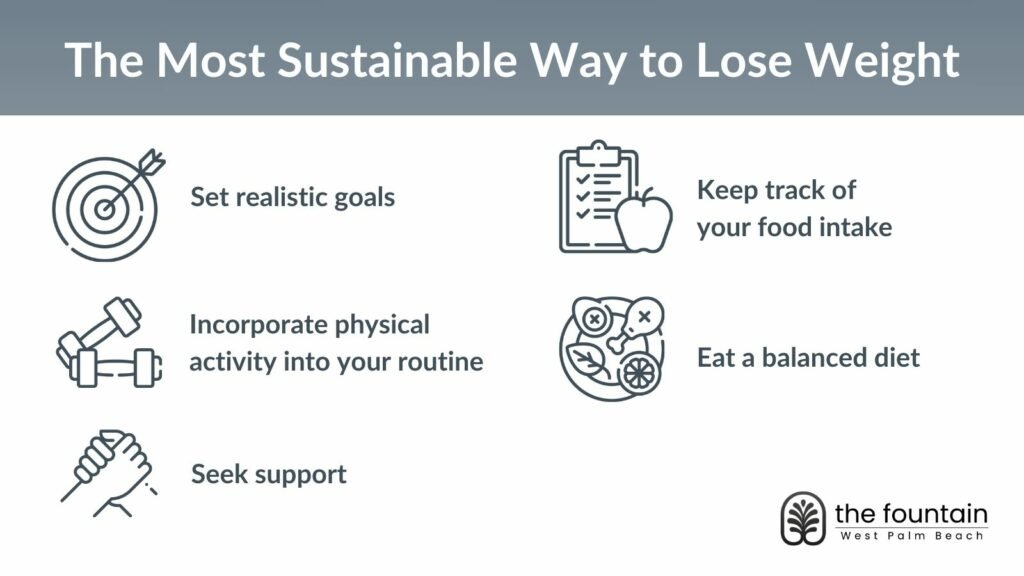Are you tired of setting weight loss goals that feel impossible to reach? You’re not alone.
Many people aim high but end up frustrated and stuck because their goals aren’t realistic. The good news is, setting achievable weight loss goals can change everything. When your goals match your lifestyle and abilities, you stay motivated and see real progress.
You’ll discover simple steps to set weight loss goals that work for you—so you can finally take control and succeed. Keep reading to find out how to make your weight loss journey both effective and rewarding.
Importance Of Realistic Goals
Setting realistic weight loss goals helps you stay focused and avoid frustration. Goals that are too hard can make you give up quickly.
Realistic goals encourage steady progress and build healthy habits. This approach makes it easier to reach your ideal weight safely.
Avoiding Common Pitfalls
Many people try to lose too much weight too fast. This can lead to burnout or health problems. Aiming for small, steady changes is safer.
Ignoring your body’s signals or skipping meals can harm your health. Listen to your hunger and energy levels to avoid these mistakes.
- Set achievable weekly or monthly goals
- Track progress without obsessing over numbers
- Focus on healthy habits, not quick fixes
- Allow flexibility for special occasions
Sustaining Long-term Motivation
Long-term motivation comes from clear, realistic goals. Celebrate small wins to stay encouraged. This keeps your journey positive.
Support from friends or groups helps you stay on track. Remind yourself why you started to keep moving forward.
- Set short and long-term goals
- Reward yourself for reaching milestones
- Find a workout or activity you enjoy
- Keep a journal of your progress

Assessing Your Starting Point
Setting weight loss goals starts with knowing where you are now. This helps you create goals that are safe and achievable.
Assessing your current weight and health gives a clear picture. Understanding your body composition adds more details.
Evaluating Current Weight And Health
Check your current weight using a reliable scale. Write down your weight to track progress over time.
Consider your overall health. Visit a doctor to measure blood pressure, blood sugar, and cholesterol.
- Record your weight and height to calculate BMI
- Note any medical conditions affecting weight loss
- Discuss your weight loss plans with a healthcare provider
Understanding Body Composition
Body composition shows the percentage of fat, muscle, and water in your body. It is better than weight alone.
Use tools like skinfold calipers or bioelectrical impedance scales. These help you see real changes in your body.
- Body fat percentage helps set accurate goals
- Muscle mass affects how many calories you burn
- Tracking changes helps adjust your plan
Setting Achievable Targets
Setting realistic weight loss goals helps you stay motivated. It keeps your plan safe and effective.
Achievable targets make it easier to track progress. They reduce frustration and keep you focused.
Determining Safe Weight Loss Rates
Safe weight loss means losing weight at a healthy pace. A common recommendation is one to two pounds per week.
Losing weight too fast can cause health problems. It can also lead to muscle loss or nutrient deficiency.
- One to two pounds per week is safe
- Rapid loss can harm your body
- Healthy loss supports long-term success
Breaking Down Goals Into Milestones
Large goals can feel overwhelming. Breaking them into smaller steps makes them easier to reach.
Milestones help you celebrate progress. They keep you motivated and show how far you have come.
- Set small, weekly or monthly goals
- Track your progress regularly
- Adjust goals based on your results
- Celebrate when you reach each milestone
Tailoring Goals To Your Lifestyle
Setting weight loss goals that fit your daily life helps you stick to them. Your goals should match what you can do regularly.
Understanding your habits and routines makes your goals easier to reach. This way, you feel motivated and avoid frustration.
Considering Time Constraints
Look at how much free time you have for exercise and meal planning. Don’t plan too much if your schedule is busy.
Small daily changes are better if you have little time. Short workouts and simple meals fit tight schedules.
- Set workout times you can keep
- Choose quick and healthy recipes
- Break goals into small steps
- Track progress weekly, not daily
Aligning With Personal Preferences
Pick activities you like to do, such as walking, dancing, or swimming. Enjoying exercise helps you stay active.
Choose foods that you enjoy and fit your diet needs. Eating meals you like makes it easier to eat healthy.
- Select favorite exercises to stay motivated
- Use recipes with foods you enjoy
- Adjust goals if your tastes change
- Include treats in moderation
Tracking Progress Effectively
Tracking your weight loss helps you see how far you have come. It also shows what works best for you.
Good tracking keeps you motivated and helps adjust your plan if needed.
Using Journals And Apps
Write down your daily meals, exercise, and feelings in a journal. This makes you aware of your habits.
Apps can track weight, calories, and activity automatically. They send reminders and show your progress with charts.
- Journals help you reflect on your journey
- Apps provide easy tracking and quick data
- Both help spot patterns and triggers
- Use what fits your lifestyle best
Adjusting Goals When Needed
Your goals might need changes as you learn what is realistic. Adjusting keeps you from feeling stuck or discouraged.
Check your progress regularly and be honest with yourself. Change goals if they are too hard or too easy.
- Set smaller goals if the big ones feel too hard
- Raise goals if you reach them quickly
- Celebrate small wins to stay motivated
- Keep your goals clear and specific

Overcoming Obstacles
Setting realistic weight loss goals can be tough. Many people face challenges along the way.
Understanding how to handle these challenges helps you stay on track and reach your goals.
Managing Plateaus
Plateaus happen when weight loss slows or stops. This can feel frustrating and make you want to quit.
To manage plateaus, change your routine. Adjust your diet or exercise to keep progress steady.
- Try new types of physical activity
- Reduce calories slightly but safely
- Track your food and activity carefully
- Stay patient and consistent
Handling Setbacks Gracefully
Setbacks are normal and happen to everyone. Do not let them stop your progress.
Learn from mistakes and keep going. Small slips do not erase your hard work.
- Accept setbacks as part of the journey
- Find what caused the setback
- Make a simple plan to recover
- Stay positive and focused on goals
Celebrating Successes
Setting realistic weight loss goals is important. Celebrating your progress helps you stay motivated.
Recognizing even small achievements can keep your spirits high and your focus clear.
Rewarding Small Wins
Small victories show you are moving forward. Reward yourself to keep the momentum going.
Choose rewards that do not harm your progress. This helps build good habits and confidence.
- Buy a new workout outfit
- Enjoy a relaxing bath
- Spend time on a favorite hobby
- Have a healthy treat
Maintaining Positive Mindset
Keep your thoughts positive during your weight loss journey. This helps you stay on track.
Focus on what you have achieved, not what you have yet to do. This reduces stress and doubt.
- Use positive affirmations daily
- Celebrate each goal reached
- Avoid negative self-talk
- Surround yourself with supportive people

Frequently Asked Questions
How Do I Set Achievable Weight Loss Goals?
Start by assessing your current weight and lifestyle. Set small, measurable goals like losing 1-2 pounds per week. Track progress consistently to stay motivated and adjust goals as needed for steady, realistic weight loss.
Why Are Realistic Weight Loss Goals Important?
Realistic goals prevent frustration and promote long-term success. They encourage healthy habits and sustainable changes. Unrealistic goals often lead to burnout or unhealthy practices, hindering progress and motivation.
How Long Should It Take To Reach Weight Loss Goals?
Healthy weight loss typically occurs at 1-2 pounds per week. Depending on your target, reaching goals may take several weeks to months. Patience is key for lasting results and maintaining overall health.
What Factors Affect Setting Weight Loss Goals?
Factors include age, metabolism, activity level, and medical conditions. Personal preferences and lifestyle also influence goal setting. Consider these to create tailored, achievable weight loss plans.
Conclusion
Achieving weight loss requires setting realistic goals. Start small. Celebrate each success. Stay patient and persistent. Weight loss takes time and effort. Listen to your body. Don’t push too hard. Enjoy the journey and learn from it. Remember, health is more important than numbers.
Stay consistent with your plan. Adjust when needed. Find support from friends or groups. Motivation helps you stay on track. Keep a positive mindset. Every step counts in reaching your goals.



